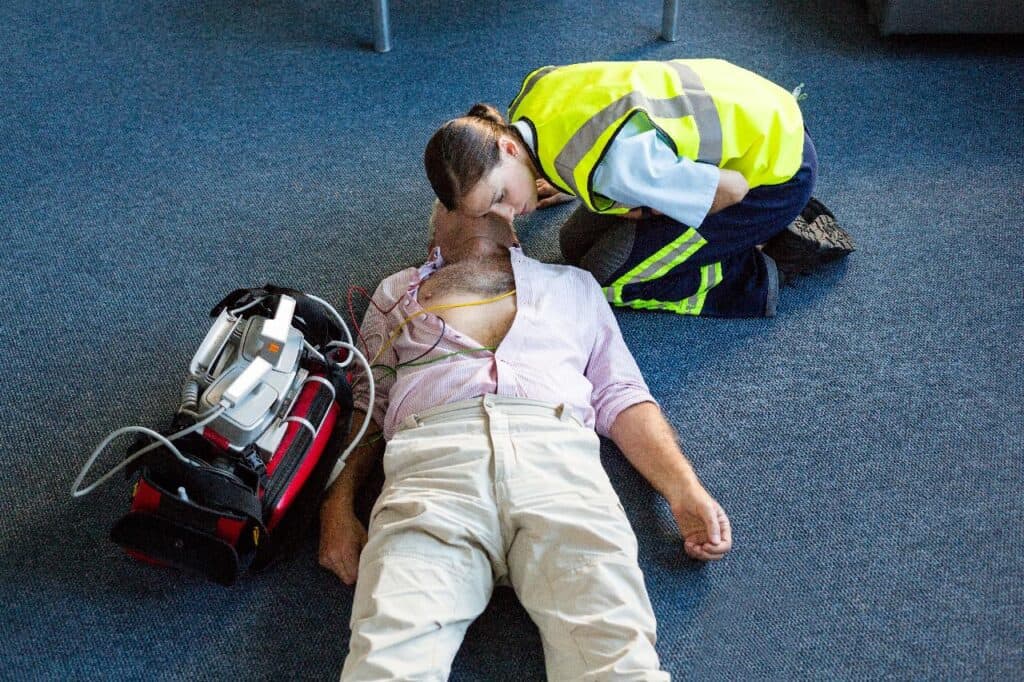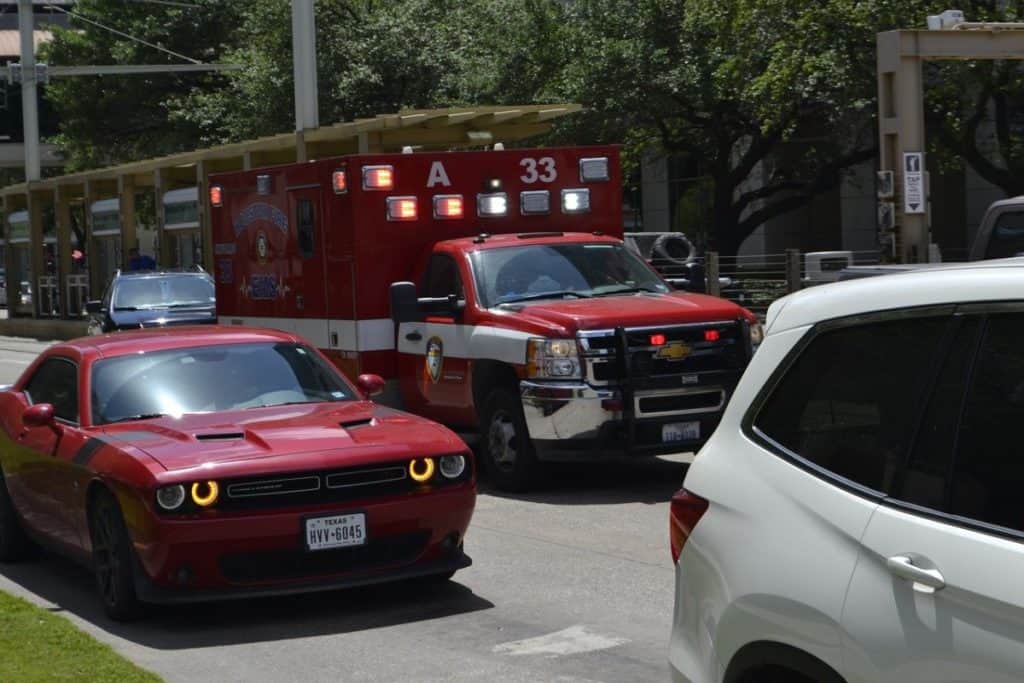Maybe you’re a female hoping to start a career as a paramedic or an EMT. Or maybe you’re an established EMS worker wondering how many women are employed in these roles? Well, the answer isn’t straightforward but we’ve dug through reams of statistics on your behalf to get you the data that we think will be of most value about women in EMS.
Approximately 30% of EMTs are female, today, with 35% of new recruits being female. For paramedics, this appears to be 20% and 23% respectively. However, these numbers can vary by source.
Lets take a look at what EMTs and Paramedics do and how that may effect the number of females in this line of work. Here’s what you need to know about women in EMS professions.
Your # 1 priority is keeping your family safe. As a firefighter, I recommend everyone has updated smoke detectors that don’t require battery changes, like these ones from Kidde, a fire extinguisher, like this one from Amerex, and a fire escape ladder if you have bedrooms above the first floor, I recommend this one from Hausse.
Also read: Do Paramedics Make More Money Than Nurses? [Salaries]
What Do EMTs Do?

EMTs or Emergency Medical Technicians are first responders who are responsible for responding to the scenes of medical and traumatic emergencies.
They need to show skills in CPR, providing oxygen for those with breathing difficulties, they may administer glucose to diabetics and may help treat allergic reactions or asthma attacks.
They do not provide any treatments (other than the use of auto-injectors for allergies) that break the skin and don’t work with needles (in most areas).
They are required to undertake up to 150 hours of EMT training and are expected to pass an examination (NREMT) which allows them to practice on completion of this training. Each individual employer and state may require additional qualifications or skills from their EMTs, there is no single “EMT skillset” defined across the USA.
The initial EMT qualification is known as an EMT-Basic certification and EMTs may undertake further study to EMT-intermediate or progress onto a paramedic course for further career development.
An EMT has all the basic skills needed to provide basic emergency care and to help transport patients to hospitals or clinics to undertake further treatment. They may also be involved with managing relationships with the patient and the broader general public in emotionally fraught circumstances.
The job is very physical and involves a fair amount of manual labor.
Also read: Can You Live Off an EMT/Paramedic Salary?
What Percentage Of EMTs Are Female?
We found many different figures for this, but we chose to employ the figures provided in the research paper, “Females and Minority Racial/Ethnic Groups Remain Underrepresented in Emergency Medical Services: A Ten-Year Assessment, 2008–2017” which was conducted by the NREMT, a body which represents all EMTs in the United States and which every EMT must register with.
Thus, you may find other figures out there, and certainly claims made post-2017 will show some variance.
However, this paper found that in 2008, women earned 28% of all EMT certification and by 2017 they were earning 35% of them. This is a substantial uplift of 25% and shows the rapid change in the profession in a short period of time.
However, it’s fair to say that not all of these people will be working as EMTs. Many people qualify as EMTs and then go on to do different jobs.
Thus, we offer an estimate of 30% of the workforce as female – this is based on several other figures as the NREMT did not specify this number in their report.
This video talks with a female firefighter paramedic about her job:
Also read: Do Firefighters Have to Be Paramedics or EMTs?
Is There A Reason That There Are So Few Female EMTs?
The NREMT was pleased to see a growth in the uptake of women in the EMT profession and they felt that this indicated that, in the future, this growth would continue.
Note: Women are just as capable in this profession as men. I have worked alongside many female EMTs, Paramedics and Firefighters that excel in their careers and are every bit as capable as their male counterparts. We are just making some guesses here as to why female may be less likely to choose this career path.
There are, however, some reasons that women may prefer not to do this kind of work when compared to men:
- Shift work is prevalent. Shift work may be a barrier to entry for women in many professions. For anyone who has a young family or intends to have one, shifts are often highly impractical, particularly as EMT workers are not highly paid and childcare can be difficult to afford.
- Large amounts of manual labor. EMT workers carry lots of heavy gear. This isn’t an impossible task for a female worker, but it is harder, on average, than it is for male workers. We’d expect automation, in the near future, to reduce this burden on both groups of workers.
- They are often more attracted to nursing. If you think the ratio of females to males in EMT and paramedic work is bad – you should be aware that only 12% of registered nurses (RNs) are male. There may simply be a traditional pull from nursing that attracts the majority of female entrants to emergency medical services.
Also read: EMT vs CNA: Which Has A Higher Level Of Training?
What Do Paramedics Do?
Paramedics are also first responders who provide emergency medical care at the scene of medical emergencies. However, a paramedic will typically undergo an additional 1,200 to 1,800 hours of training when compared to an EMT.
This means that a paramedic is a more highly skilled provider of care. They have education in anatomy, physiology, medication administration, and medical procedures.
A paramedic can give injections, they can start an IV, they can help to regulate the patient’s airways, they can support and resuscitate patients at a very advanced level.
Paramedics are also involved, as are EMTs, in transporting patients to hospital thought they may provide a higher level of care and/or support whilst en route to a clinic or hospital.
In the majority of emergency healthcare incidents, there is unlikely to be a more highly qualified healthcare provider on the scene than a paramedic. This is reflected in higher rates of compensation when compared to EMTs and with higher levels of responsibility.
All paramedics will have undertaken an EMT-basic course prior to studying as a paramedic and many will have worked as an EMT for a year or two. It is a natural progression from an EMT role and a progression that many people will make during their EMS career.
Also read: How Long Does It Take To Go From EMT To Paramedic?
What Percentage Of Paramedics Are Female?
Again, sources on this vary considerably and we opted to use the research in the “Females and Minority Racial/Ethnic Groups Remain Underrepresented in Emergency Medical Services: A Ten-Year Assessment, 2008–2017” report for this for consistency’s sake.
They painted something of a different picture for paramedics when compared to EMTs in the workforce.
They showed that, in 2008 only 20% of entrants to the paramedic profession were female and that by 2017 this had only increased to 23%.
Thus, we derive an optimistic estimate of female paramedics as, perhaps, 20% of the workforce.
The NREMT felt that this was not good enough and that the next decade or so would require further efforts to attract women to the profession.
In this video, a woman who went from being an occupational therapist in the hospital to a firefighter paramedic talks about her career change:
Also read: Paramedic vs Firefighter: What’s The Difference?
Is There A Reason That There Are So Few Female Paramedics?
Yes, in fact, much the same reasons that women are less likely to become EMTs than men. While paramedic is a more highly-skilled job, there’s no doubt that it shares similar negative aspects to EMT work – shifts, heavy labor, etc.
It’s also worth noting that a paramedic is probably closer in stature to a registered nurse than an EMT – though a nurse requires a degree whereas a paramedic usually does not.
This may mean that the potential female workforce for paramedics is substantively lower than it is for EMTs, because of the huge gender bias (in favor of women) in registered nursing.
One thing is for sure though: women can and do excel in both EMT and paramedic roles and may even find it slightly easier to secure a position at a time when women are under-represented in the workforce. This shouldn’t be seen as a barrier to entry to the profession at all.
Conclusion
What percentage of EMTs are female? In fairness, this is something of a “how long is piece of string?” question. This is because, in general terms, there are many different ways to measure this figure and each produces a different outcome. However, it seems that about a third of EMTs are female and that this figure is increasing on a year-on-year basis.
As for female paramedics? There is farther to go. With about 1 in 5 paramedics being female though 1 in 4 newly qualified paramedics are female.
Related Articles:
How to Become an EMT: Expert Guide
Firefighter vs Nurse: Which Job Is Better?

